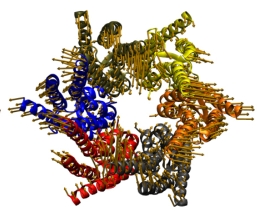CO2 sensor: if blood's too acid, you die
Interview with
A nerve cell, connexin, can detect carbon dioxide, and could be involved in processes as diverse as breathing,  hearing and reproduction.
hearing and reproduction.
Louise - You need to monitor the amount of CO2 in your blood. CO2 reacts with water to make hydrogen ions, so it makes the blood more acidic and because enzymes are sensitive to that, if your blood gets too acidic, then you'll die.
Chris - So, how did scientists and doctors think that CO2 was registered prior to you coming along?
Louise - So the main theory is that it's by pH, so that's measuring the amount of these hydrogen ions. And there's lots of evidence for that, and it's definitely involved. But there's more evidence that CO2 is monitored directly as well, which is what we're looking into.
Chris - And in order to do that, A - where would that happen, and B - how?
Louise - We look in the brain, in the medulla that's in the brain stem. And previous results have shown that if you take pH out of it. So if you keep the level of hydrogen ions constant but just change the level of CO2, you still get a response. If you do this with animals, they still increase their breathing in response to CO2.
Chris - So, something in that part of the brain is clearly very sensitive, not necessarily just to the pH, but definitely to the CO2 molecule itself.
Louise - Exactly.
Chris - So, how did you approach that?
Louise - One protein, called connexin 26, found in this area of the brain that's involved with breathing. It makes pores in the membrane. So, six of these proteins get together and make a hemi-channel, it's called. So, because they're found in the area of the brain that's involved with respiration, my group thought they might be involved.
Chris - And when they're just normally expressed on cells - these connexions - to make these pores, what goes in and out of those pores?
Louise - So, it's quite a big hole. One kilodalton is the size of things that get through. So, signalling molecules like ATP.
Chris - So, how do think that the CO2 might interact with one of these tubes?
Louise - My group has already shown that connexin 26 do open in response to CO2. And what I was looking for was a binding site, somewhere where CO2 can attach to the channel to make it open.
Chris - Was there anything you could look at before you embarked on that as a sort of a hypothesis. We know it works in this context in this way, so is it doing the same thing to this connexin?
Louise - Yes. So, that's what we started with. So, we know that CO2 can bind to some molecules by making what is called a carbamate residue. So, that's when the CO2 binds to a particular amino acid, which is called lysine. And these are found in plants and animals, and in haemoglobin in the blood, so we started with the hypothesis that that's what happened here.
Chris - And then how did you pursue that?
Louise - We know that connexion 26, which is the one that I work on, is CO2-sensitive. But we also know that two connexins that are related to it, are also sensitive. They also open to CO2. So, what we did was we looped some lysines that were present in all three of these, but absent in another member of the family that we knew wasn't CO2-sensitive.
Chris - That's clever. So, what they basically did is to direct your attention towards one possible part of the protein. So, what did you then manipulate that region to see if you could fool the one that doesn't normally respond to CO2 into responding to CO2, and that would prove then that you've found the real area.
Louise - Yes, exactly. So, what we did was the took that out and mutated a non-sensitive connexin, connexins that you want to have those residues and then we looped to the CO2-sensitive of that. And as we expected, it became CO2-sensitive.
Chris - So, when CO2 goes onto this lysine, what does it do to make the channel alter its activity?
Louise - So, we believe it's through what we would call a salt bridge interaction, electrostatic interaction. So, when the CO2 binds, and makes this new residue, it has a negative charge. And then we're looking at the hemi-channel, so it's six of these connexins next to each other. On the next connexin, there is a positively charged amino acid, really close to the lysine. Close enough that they could have an interaction. So, we believe you end up with an interaction between sub-units, changing the confirmation of the channel which could open it.
Chris - And have you managed to test yet, to see whether this really happens in vivo, in the brain stem or is this, at this stage, just a theory?
Louise - We've done mutational studies where we've taken away the positive end and shown that it stops the channel working. But in terms of the animal tests, they're ongoing.
Chris - And if you have nailed this, what are the implications both scientifically and clinically?
Louise - So, it's quite exciting. If we can identify this is the CO2 binding site, it makes connexin 26 a CO2 receptor. The connexins have never been suggested as receptors before. And because they have such a large pore, the opening of these channels would allow big molecules in and out of the cells. There's the possibility that connexins could be receptors for ligands, that they just haven't been recognised as yet.









Comments
Add a comment